Friday, December 14, 2012
When asked about eating fish, many people claim they just don’t know how to cook it properly. Thus, before I post some more of my favorite seafood dishes like those pictured here, I decided to take a minute to discuss the main methods I employ. This is not to say there aren’t other techniques, but if you master these three you are well on your way to enjoying fish at home. (And don’t forget to remain cognizant about the sustainability of the fish you’re eating, what’s in season, and so forth: check out National Geographic and Monterey Bay Aquarium for more information to assist you in making planet-friendly choices.)
1. Oven Roasted: Slow and Low
Slow roasting is a sure-fire method for cooking fish, and it could not be easier. All you need do is set the oven to 300, 325 degrees F (ovens vary) and set your piece of fish in there for 20-40 minutes (depending on thickness and desired temperature). I generally cook a 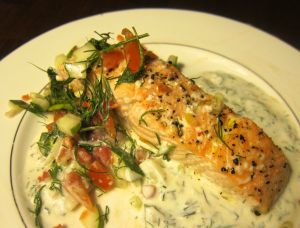 piece of meatier fish using this method at 325 degrees for 20 minutes or so, and then it will sit an additional 5 minutes to rest and absorb the juices (as you would do for meat). Always tender and juicy, never dry, it’s a wonderful way to enjoy fish. Fishes I generally cook using this method include salmon, bass, halibut, swordfish, monkfish, and blue fish; hake, cod, and haddock also work well (and tend to take a bit less time). Just drizzle olive oil on the fish and lightly season with salt and pepper for an everyday preparation. Salmon is roasted just like that in this example and then served with a chopped Greek salad and Tzatziki (Greek yogurt sauce). Fancier preparations might quickly sear the fish to get a lovely color and texture (see method #3 below) and then roast it in the oven to cook it through while whipping up a quick pan sauce, like my swordfish piccata with smashed cauliflower and Brussels sprouts.
piece of meatier fish using this method at 325 degrees for 20 minutes or so, and then it will sit an additional 5 minutes to rest and absorb the juices (as you would do for meat). Always tender and juicy, never dry, it’s a wonderful way to enjoy fish. Fishes I generally cook using this method include salmon, bass, halibut, swordfish, monkfish, and blue fish; hake, cod, and haddock also work well (and tend to take a bit less time). Just drizzle olive oil on the fish and lightly season with salt and pepper for an everyday preparation. Salmon is roasted just like that in this example and then served with a chopped Greek salad and Tzatziki (Greek yogurt sauce). Fancier preparations might quickly sear the fish to get a lovely color and texture (see method #3 below) and then roast it in the oven to cook it through while whipping up a quick pan sauce, like my swordfish piccata with smashed cauliflower and Brussels sprouts.
2. Pan-fried: Medium and Gentle
As it sounds, this method will coat a pan with a little olive oil (or another vegetable oil you 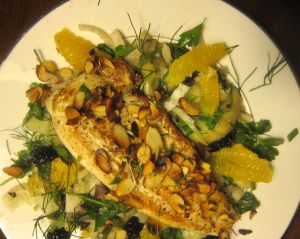 like) and fry it for a few minutes on each side. You’ll use medium-high heat here, which will create a crispy coating on the fish as it cooks quickly in the oil. (No bread crumbs required!) I generally use this method for thin fillets like sole, flounder, catfish, tilapia, and trout; it takes about 2-3 minutes each side. Here, pan-fried trout is served atop a salad of fennel, herbs, oranges, blackberries, and toasted almonds. Note that I use the word ‘gentle” here because some of the thinner fillets can sometimes break when turning them. If that happens, don’t sweat it: it’s just as good!
like) and fry it for a few minutes on each side. You’ll use medium-high heat here, which will create a crispy coating on the fish as it cooks quickly in the oil. (No bread crumbs required!) I generally use this method for thin fillets like sole, flounder, catfish, tilapia, and trout; it takes about 2-3 minutes each side. Here, pan-fried trout is served atop a salad of fennel, herbs, oranges, blackberries, and toasted almonds. Note that I use the word ‘gentle” here because some of the thinner fillets can sometimes break when turning them. If that happens, don’t sweat it: it’s just as good!
3. Seared: Hot and Fast
Searing fish creates a delightful crust on the outside while keeping the inside cooler, 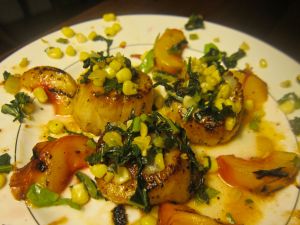 ensuring the desired rare to medium-rare temperature for many fishes. Tuna would be the best example, or sea scallops. Heat an oil with a high smoke point, like peanut, over high heat. When very hot, place seasoned fish into the pan and cook to desired temperature. Tuna takes a very short time, often 1-2 minutes per side for a rare center. Scallops can go for about 2 minutes per side, depending on size. Examples: sea scallops with grilled peaches, kale and corn (pictured) or tuna puttanesca with creamy polenta.
ensuring the desired rare to medium-rare temperature for many fishes. Tuna would be the best example, or sea scallops. Heat an oil with a high smoke point, like peanut, over high heat. When very hot, place seasoned fish into the pan and cook to desired temperature. Tuna takes a very short time, often 1-2 minutes per side for a rare center. Scallops can go for about 2 minutes per side, depending on size. Examples: sea scallops with grilled peaches, kale and corn (pictured) or tuna puttanesca with creamy polenta.
Now that you have the basics, check out the recipes above for more inspiration and please return again to The Nutrition Doctor for more delectable dishes. With a little practice, you’ll be cooking up healthy, sustainable seafood like a pro.

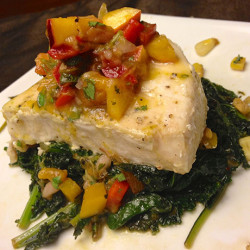
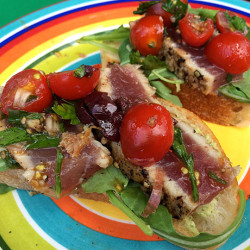
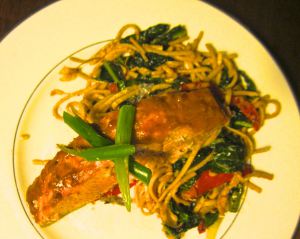
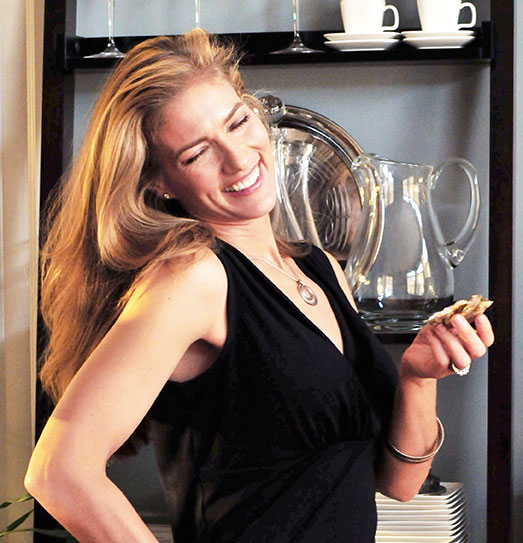
There’s a lot of good info here – and good eating, too!
this was super helpful! I often don’t eat seafood bc I don’t know what I’m doing. thanks!